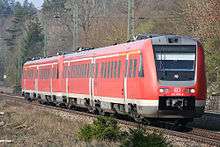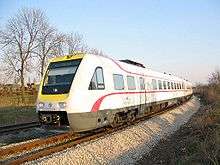RegioSwinger
| RegioSwinger | |
|---|---|
 A RegioSwinger in use as Allgäu-Franken-Express in Treuchtlingen | |
|
A Croatian RegioSwinger in Rijeka, Croatia | |
| Manufacturer |
Adtranz, Hennigsdorf factory Bombardier Transportation |
| Constructed | 1998-Present |
| Number built | 192(8 in HŽ,184 in DB) |
| Specifications | |
| Train length | 51,750 mm (169 ft 9 in) |
| Maximum speed | 160 km/h (99 mph) |
| Weight | 116 t (114 long tons; 128 short tons) |
| Prime mover(s) |
Cummins QSK-19, at each end |
| Engine type | Diesel |
| Power output | 2 x 560 kW (751 hp) |
| Transmission | Hydraulic |
| UIC classification | 2'B'+B'2' |
| Coupling system | Scharfenberg coupler |
| Multiple working | Up to 4 sets |
| Track gauge | 1,435 mm (4 ft 8 1⁄2 in) standard gauge |
The RegioSwinger is a tilting diesel multiple unit (DMU) passenger train used for fast regional traffic on unelectrified lines.
Development and service
The RegioSwinger was first manufactured by Adtranz in Hennigsdorf, before it became part of Bombardier Transportation in 2001. The train is in use in Germany with Deutsche Bahn as class 612 and was introduced to Croatia with Croatian Railways as HŽ 7123 or InterCity Nagibni (ICN) in 2004.[1] The public shortened that name, so it caught the nickname nagibni (swinger) in Croatia, and became known also by that short name, due to commercials.
Class 612's predecessor was class 611, which due to heavy problems with the tilting system and the chassis was largely considered a failure. Even though class 612 sticks to the principle of an electric tilting system (Neicontrol-E), it was newly engineered from the beginning.
The first units were delivered in 1998 and worked reliably until 2004, when cracks were detected in a number of wheel sets. For safety reasons, the tilting system was disabled and subsequently the maximum speed on tilting lines was reduced, causing a massive disorder in the schedules. As before with class 611, wheels and axles had to be replaced. Starting in 2005, class 612 was equipped with hardened molybdenum axles. Today class 612 is back to tilting operation and forms the backbone of DB's fast regional service on un-electrified lines.
After ICE TD class 605 was grounded due to a fracture of an axle in one unit, it was replaced by class 612 on the Dresden-Munich line 2003, as replacement by anything other than a tilting DMU would have meant an extension of travel time. Even though class 612 was not constructed for ICE-type travelling comfort, 16 units were repainted in the ICE paint scheme and renumbered as class 612.4. Ironically, only one year later the same problem forced DB to disable the tilting system on the replacement also.
Technical information
Class 612 units comprise two motorised coaches, each with a 560 kW (751 hp) Cummins engine (type QSK-19). The power is transferred hydraulically. Up to four units can be connected by the Scharfenberg coupler, with the on-board computers automatically choosing the train configuration.
Besides pneumatic brakes and a hydraulic braking system, class 612 is also equipped with an electro-magnetic brake. The maximum tilt is 8°.
Accidents
On July 24, 2009, a train derailed near Rudine, Croatia, with 119 passengers aboard, killing 6 and injuring 55, on the Zagreb-Split line.[2] According to Croatian news reports, the cause of the derailment was slippery fire retardant that was just sprayed on a steep downhill section of the track, a normal practice in extreme summer heat but executed improperly using a new chemical. With brakes ineffective, the train gained a speed higher than the track configuration could handle and derailed[3] .[4][5]
Croatian news media report that this section of the track was reconstructed in 2005 and that the particular train passed inspection just two days prior to the accident, but the accident brought back the debate on whether these trains are appropriate for local conditions. Investigation continues, with questionable application of fire retardant (recently changed to "aqueous based resin liquid penetrate" TG-300[6] from a new supplier) emerging as the most likely cause of this accident.
Gallery
 The Croatian version of the RegioSwinger: InterCityNagibni.
The Croatian version of the RegioSwinger: InterCityNagibni..jpg) A German RegioSwinger in a tilting operation.
A German RegioSwinger in a tilting operation. Bogies
Bogies
| Wikimedia Commons has media related to HŽ Class 7123. |
Comfort
- Passengers have criticised that the seats in class 612 are too hard, especially for longer distances.
- Class 612 in Germany has been nicknamed Wackel-Dackel (wobbling Dachshund).
- The tilting effect causes motion sickness in some people.
References
- ↑ nov-ost.info - Erste "Regioswinger" für Kroatien
- ↑ Derailment location (estimated)
- ↑ Jeziva željeznička nesreća
- ↑ Kriv je premaz pruge - slijede prijave
- ↑ Vlak smrti: Glavni predmet istrage Ivan Medak i Drago Rogulja
- ↑ TG-300 Outdoor Applications